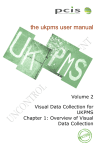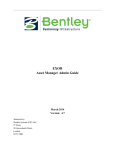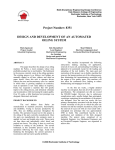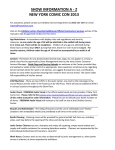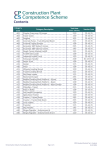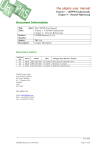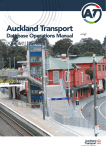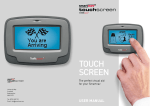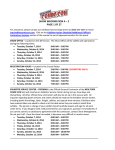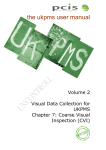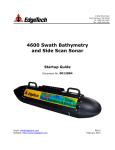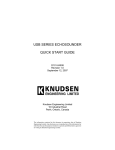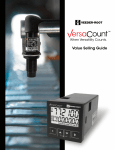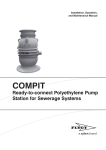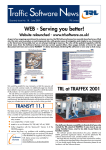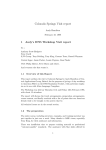Download the ukpms user manual - Pavement Condition Information Systems
Transcript
the ukpms user manual Volume 2 Visual Data Collection for UKPMS Chapter 5: Inventory the ukpms user manual Volume 2: Visual Data Collection for UKPMS Chapter 5 Inventory Document Information Title (Sub Title) Product Number Author Description The UKPMS User Manual Volume 2: Visual Data Collection for UKPMS Chapter 5 Inventory UKPMS Manual July 2009 James Wallis This document describes the method of and provides guidelines and recommendations for inventory data collection. Document History Version No Status Author Date Changes from Previous Version 01 Draft JW 01/02/05 02 Released JW 06/05/05 03 04 05 06 07 08 Revised Final Revised Review Revised Final JW JW JW JW KAG ME 30/06/05 July 2005 July 2009 Sept 2009 Oct 2009 30 Oct 2009 First draft for internal review based on the UKPMS Inventory Sub Group paper on data collection by M Thomas Incorporating comments from Visual Survey Sub Group and new document style Version for proof reading Final for release Incorporating changes since 2007 Issued for external review Revised following review Final for release PCIS Support Contractor TRL Crowthorne House Nine Mile Ride Wokingham Berkshire RG40 3GA www.pcis.org.uk Email: [email protected] Phone: +44 (0)1344 770480 Fax: +44 (0)1344 770356 UKPMS Manual_02_05v08.doc October 2009 Page 2 of Chapter 5 the ukpms user manual Volume 2: Visual Data Collection for UKPMS Chapter 5 Inventory Contents 1 2 3 4 5 6 7 8 9 10 Introduction ........................................................................................................................ 4 Overview of Inventory Survey ......................................................................................... 5 Data collection considerations .......................................................................................... 6 Is the network referencing up to date? ............................................................................ 6 Items/attributes to be collected ....................................................................................... 7 Cross Sectional Position (XSP) Referencing .................................................................. 7 Extent of Survey ................................................................................................................. 7 Inventory Item Parameters................................................................................................ 8 Changes to Inventory Attributes ...................................................................................... 8 Inventory Survey Procedure ............................................................................................. 9 10.1 Data collection considerations.......................................................................................................9 10.2 Start and end location of section...................................................................................................9 10.3 Nominated Sections ........................................................................................................................9 10.4 Width Measurements ......................................................................................................................9 10.5 Feature Hierarchy ......................................................................................................................... 10 10.6 Double Counting Errors ............................................................................................................. 10 10.7 Road junctions .............................................................................................................................. 10 10.8 Junction bell-mouth areas ........................................................................................................... 11 10.9 Turning heads in cul-de-sac roads ............................................................................................. 12 10.10 Roundabouts ............................................................................................................................. 13 10.11 Lay-bys ....................................................................................................................................... 14 10.12 Remote Footways ..................................................................................................................... 16 10.13 Cycle tracks................................................................................................................................ 16 10.14 Change of Cross Sectional Position....................................................................................... 16 10.15 Maintenance of Inventory data .............................................................................................. 16 11 Typical Inventory Items................................................................................................... 17 11.1 Carriageway ................................................................................................................................... 18 11.2 Central Island ................................................................................................................................ 19 11.3 Cycle Track .................................................................................................................................... 20 11.4 Footway.......................................................................................................................................... 21 11.5 Kerb ................................................................................................................................................ 22 11.6 Longitudinal Joint ......................................................................................................................... 24 11.7 Transverse Joint ............................................................................................................................ 25 11.8 Transverse Kerb ........................................................................................................................... 26 11.9 Verge .............................................................................................................................................. 27 12 Typical Inventory Rules ................................................................................................... 28 12.1 Typical detail for collecting inventory widths .......................................................................... 30 12.2 Typical detail for surveying a roundabout ................................................................................ 31 12.3 Typical detail for junction ........................................................................................................... 32 12.4 Typical detail for starting a section ............................................................................................ 33 12.5 Typical detail if footways extend beyond the carriageway ..................................................... 34 UKPMS Manual_02_05v08.doc October 2009 Page 3 of Chapter 5 the ukpms user manual Volume 2: Visual Data Collection for UKPMS Chapter 5 Inventory 1 Introduction Table 1 shows the inventory items and respective attributes that may be collected, for use within a UKPMS system Item Carriageway Cycle Track Footway Kerb Lay By Longitudinal Joint Transverse Joint Transverse Kerb Verge Item Code Attribute_1 Attribute_2 CW CT FW KB LB LJ TJ TK VG Surface type Surface type Surface type Material Surface type Length Length Material Surface type Width Width Width Length Width No No Length Width Table 1 Inventory Items Inventory data are used by UKPMS during the processing of condition data. While not essential to the system, inventory data will affect the way condition data is processed by providing information on the area of the highway in which a defect has been recorded. This in turn can influence the selected treatments, ranking and estimated cost of repair. If no inventory data is available, default values for features are allocated. These values are applied to all road sections of the same type (i.e. all single 2-lane carriageways will be assumed to have the same width of carriageways, footways etc.) as defined in the system Rules and Parameters. There are only two mandated inventory items which are required for UKPMS processing. These are transverse and longitudinal concrete joints. These are required to assist in the processing as it is not possible to estimate how many or where the joints are in a road section. Inventory is also used within UKPMS for asset management purposes and will be used for determining the value of the asset and the Depreciated Replacement Cost (DRC) for Whole of Government Accounts (WGA). It should be noted that the term Inventory in UKPMS currently refers to the length, width, surface and construction of highway features. As such it does not equate to the same term used in more comprehensive systems such as RMMS. This document describes considerations and methodology of inventory data collection and while not exhaustive, provides guidelines and recommendations for data collection. UKPMS Manual_02_05v08.doc October 2009 Page 4 of Chapter 5 the ukpms user manual Volume 2: Visual Data Collection for UKPMS Chapter 5 Inventory 2 Overview of Inventory Survey The survey is normally conducted on foot, although alternatives such as collection by video survey are also available. The survey collects the location of highway features by start and end chainage, measured from the section’s start point. It is important that network characteristics, such as the zero chainage location of a section are clearly specified. Double counting of inventory assets must be avoided. The method for data collection must ensure that inventory and defect data are collected consistently for all survey types. The width of a feature is also measured at the start and end chainages, where appropriate, and lateral position is recorded using cross sectional position (XSP) codes. Details of the XSP codes can be found in Chapter 6 Cross Sectional Position (XSP) of Volume 2 of this UKPMS User Manual. The widths are used to calculate the area of the feature, but additional properties are also recorded as specified in the UKPMS Rules and Parameters. A feature is regarded as continuous along a section until one of its parameters changes (such as the end of a footway or change in width, a difference in construction, change of cross sectional position etc.). Inventory data can be collected electronically or on paper. Electronic data collection is recommended as this minimises duplication of work and reduces the need for data validation which may be carried out by the data collection software. If undertaken as a paper exercise, a method of validating and transferring the data into UKPMS will be required. The UKPMS Rules and Parameters list the inventory items and associated attributes which can be loaded into accredited UKPMS systems. It is useful if the information collected during an inventory survey is given to the surveyors who carry out assessment surveys to ensure they record the defects in the same cross-sectional position as the inventory. UKPMS Manual_02_05v08.doc October 2009 Page 5 of Chapter 5 the ukpms user manual Volume 2: Visual Data Collection for UKPMS Chapter 5 Inventory 3 Data collection considerations Inventory data are used in UKPMS in the following areas: 1 To refine pavement types using construction information 2 To calculate area of defects 3 In estimating costs of works 4 To map CVI defects collected at minimal XSP on sections using full XSP referencing. 5 To support DVI surveys Table 2 Uses of UKPMS pavement inventory items The Inventory data collected should support other survey data held in the system to improve the quality of the processed results. The most important questions to be answered before conducting a survey are: Is the Network referencing up to date? What items/attributes are to be collected? What level of cross sectional position is to be used? (must be the same as defined by the network) Extent of Survey? To help decide on the type and extent of data collection, some further information on these points is given below. 4 Is the network referencing up to date? A model of the network to be surveyed should be in place in advance of the data collection exercise. This is necessary for a number of reasons including Providing the network section references and direction to record data against To locate the start and end locations of data collection for surveys (see below) To be able to scope and price the work To ensure required survey parameters are defined Section XSP Level Footway hierarchy values Nominated sections Inventory collection/loading problems can occur if section start and end points for data collection at road junctions are not clearly defined. The larger the junction and further from a 90º turn the junction is, the more prominent this problem will become. Essentially two options of network modelling exist. Firstly data can be collected from the notional node point (i.e. 0 chainage runs from the centre of the UKPMS Manual_02_05v08.doc October 2009 Page 6 of Chapter 5 the ukpms user manual Volume 2: Visual Data Collection for UKPMS Chapter 5 Inventory adjoining road). Alternatively, data collection begins from the white lining of the junction, although a GIS model may indicate the section as ‘notionally’ starting from the centre of the adjoining road. Although both methods are valid, it is imperative that a single interpretation is applied across the network for all data collection. It is recommended that the second approach is adopted as this will minimise the exposure to traffic during walked surveys, makes determination of the start point of a section easier for driven/machine surveys, and ensures that the recorded section length matches the carriageway length. If instigating this recommendation, users should be aware that differences between section ‘digitised’ (i.e. GIS) and site ‘measured’ lengths can on occasion be significant and this can affect the quality of data location when displayed in GIS. Users should also be aware that the default loading tolerance for inventory data is 5% (section length) or 20m, whichever is the greater. Because of this, care must be taken in setting up the network to avoid extensive time being spent sorting out postsurvey data fitting problems. 5 Items/attributes to be collected If only carriageway information is required within the database, the collection of other items may be redundant and so may not be collected. It is possible to collect additional inventory at a later date and append this to existing data (see Section 7 Extent of Survey below). 6 Cross Sectional Position (XSP) Referencing Inventory data can be collected using either Full or Minimum Cross section Position Referencing as described in Chapter 6 Cross Sectional Position (XSP) of Volume 2 of this UKPMS User Manual. The level of referencing used is an attribute of network sections and cannot be defined by the data collection exercise. Because of this, the level of XSP referencing must match that defined by the section or it will not load into UKPMS. This is important in relationship to carrying out machine surveys on your network. If you carry out machine surveys you MUST collect inventory to FULL cross-sectional positions. If you do not have this information within your system then you will not be able to process your data. 7 Extent of Survey Inventory data may be collected on one of more features on a section in any survey. For example, users may decide to collect only carriageway inventory initially and collect footway inventory at the same time as undertaking a DVI survey. This has UKPMS Manual_02_05v08.doc October 2009 Page 7 of Chapter 5 the ukpms user manual Volume 2: Visual Data Collection for UKPMS Chapter 5 Inventory the advantage of ensuring that the two different data types are collected consistently, minimising the potential of data loss during loading and processing. When inventory data is collected and loaded/committed into UKPMS, the user will typically have some control over how the data will replace the existing records in the database. Users should refer to their system documentation to determine the updating/overwriting options available. 8 Inventory Item Parameters All UKPMS Inventory items have the following attributes. Whether the information is collected will depend on the feature being collected. For example, Kerbs do not have a width measurement. The UKPMS Rules and Parameters give valid values for: Feature Hierarchy, Surface Types and Construction. They are: Start Chainage End Chainage Start Width – Not for Kerbs End Width – Not for Kerbs Feature Hierarchy – To be defined by the user Surface Type – Defined as ‘Material Type’ for Kerbs Construction – Not for Kerbs All chainage measurements are to the nearest metre. It is not possible to know from observation what the construction of a feature is. For example a road may appear to be bituminous, but is actually concrete overlaid with bituminous. Attribute must be collected using what is known rather than what could be assumed and as such should not be made the responsibility of the Surveyor. 9 Changes to Inventory Attributes Whenever the surface, construction or feature hierarchy changes (material type for kerbs), the creation of a new inventory item is the only way to record the change. Alternatively, if all inventory data is collected as having an unknown surface type and construction, then only any changes to the hierarchy need to be recorded; this alternative results in fewer records within the database, and reduces potential data conflicts. UKPMS Manual_02_05v08.doc October 2009 Page 8 of Chapter 5 the ukpms user manual Volume 2: Visual Data Collection for UKPMS Chapter 5 Inventory Inventory Survey Procedure 10 10.1 Data collection considerations Significant variations in road and feature layout can occur when recording inventory. The selected method must ensure the collection of data is consistent for all survey types. It is important that inventory and other survey data are collected to complement rather than conflict with each other. Alignment of inventory and condition data can have implications for data processing, especially in connection with DVI data so the sections below explain steps which can be taken to minimise data conflicts. 10.2 Start and end location of section Inventory data can be collected in either the forward or reverse direction of the section, further information on survey direction is given in Section 7.3 Survey Direction of Chapter 1 Overview of Visual Data Collection of Volume 2 of this UKPMS User Guide. When collecting data in the reverse direction, cross sectional positions should be recorded as they are observed, recording the direction of the survey as reversed means that UKPMS will reverse the data and XSP codes automatically. Definition of the start and end point of sections needs to be defined by the network model, (Section 7.3 Survey Direction of Chapter 1). All data collection must be undertaken consistently to the network model or data conflicts between different surveys will be likely, leading to survey data either not being accepted into the database, or being lost during UKPMS processing. 10.3 Nominated Sections Two different network sections may both contain the same feature, such as the central reservation of a dual carriageway. To avoid data being either collected twice or not at all on these features, one of the two adjoining network sections can be assigned as the nominated section. This is a network attribute that indicates which section will have the shared features data assigned to it. 10.4 Width Measurements The recorded width at the start and end of all inventory items must be exactly as measured on site. UKPMS calculates all areas as trapezoids, so there is not a limitation requiring start and end widths to be the same. By making measures of the start and end width of each feature as individual areas, it will also produce the best measure of the area as it exists on the ground. See also Section 10.10 below for specific requirements for roundabouts. UKPMS Manual_02_05v08.doc October 2009 Page 9 of Chapter 5 the ukpms user manual Volume 2: Visual Data Collection for UKPMS Chapter 5 Inventory 10.5 Feature Hierarchy The associated hierarchy for Carriageway, Footway and Cycletrack features is defined in the Code of Practice for Maintenance Management. The carriageway hierarchy is defined for all carriageways as a network section attribute which must be defined. Footways can also have a default Hierarchy assigned as an attribute of section, but footways and cycle tracks can have their own Hierarchy defined during Inventory data collection. This ability is useful where the hierarchy of a non-carriageway item changes within the limit of a single network section. However, hierarchy attributes must be defined by the User in advance of any survey work. The surveyor will not be able to make an informed assessment of a site, as there will not be enough time available during the survey. 10.6 Double Counting Errors Data collection needs to be consistent and represent features as they appear on the ground. It is important that where areas of two road sections overlap, the features common to both are recorded against a single section for inventory and all other survey types. Most examples of this occur at junctions where the off carriageway features are common to two (or more) network sections. All UKPMS surveys must apply the same method to ensure that recorded defects correspond to each other and also to record inventory consistently. The methods described below are not definitive. They are suggestions for a simple and consistent model to minimise confusion of the location of items collected. Data collection must always follow the locally defined method to ensure consistency with any previously and subsequently collected UKPMS data. 10.7 Road junctions When crossing a junction with another road which is a separate section, all offcarriageway items must be collected to the end-chainage and then picked up again on the other side of the junction. The off carriageway items on the main section should be recorded as if they continue in a straight line to the kerb edge on both sides of the junction, as shown in Figure 1; this avoids double counting areas. Similarly, when measuring items on the side road (Section B), the carriageway item will start at the white lines of the junction, but the off carriageway items must not be recorded until the start of the area which has not been recorded against the adjacent road section (Section A). UKPMS Manual_02_05v08.doc October 2009 Page 10 of Chapter 5 the ukpms user manual SECTION B Volume 2: Visual Data Collection for UKPMS Chapter 5 Inventory Area to be collected with Section A Note kerb collection stops at the tangent point SECTION A Figure 1 Inventory Area to be collected 10.8 Junction bell-mouth areas Only a few items need to be collected to measure a bell mouth area with reasonable accuracy when using a trapezoidal method. If many items are collected on short measurements, data could be lost during data fitting. Typically, measuring an entire bell-mouth as one item will overestimate the areas by about 25%, but taking two measures reduces this error to about 5%. Figure 2 shows the trapezoidal method. UKPMS Manual_02_05v08.doc October 2009 Page 11 of Chapter 5 the ukpms user manual Volume 2: Visual Data Collection for UKPMS Chapter 5 Inventory FW VG VG FW C/W Measure as single Trapezoid ~ +25% Measure as two Trapezoids ~ +5% VG FW Figure 2 Junction bell-mouth areas 10.9 Turning heads in cul-de-sac roads Users need to establish their own convention to define when turning head areas should be measured as a change in carriageway width, or when these should be considered as separate sections. Small areas of less than 10 sq m – 20 sq m can be easily recorded as a wider area of carriageway and this will simplify future data collection. Where a footway runs at the back of the carriageway at the top of a turning head, the recorded Inventory cannot exceed the section length as defined by the carriageway limit. To compensate for this, Transverse XSP codes can be used to record the item, using a dummy start chainage based on measuring the length of the feature back from the end chainage of the section. As the item is recorded against a Transverse XSP code, there will not be a system conflict due to overlapping chainage of features. As with other data collection rules, local decisions need to be made to ensure data consistency, but one method is illustrated in Figure 3. UKPMS Manual_02_05v08.doc October 2009 Page 12 of Chapter 5 the ukpms user manual Volume 2: Visual Data Collection for UKPMS Chapter 5 Inventory LT RT LT LT RT RT Max. Chainage LT LT LT L RT RT C/W FW VG VG FW L2 L1 R1 R2 FW VG VG FW Figure 3 Turning Heads The off carriageway features need to be measured backwards from the end carriageway chainage to the tangent point at the start of the turning head feature. Using the appropriate Transverse XSP code, the detail will be consistently picked up and the area of the feature accurately recorded. If Transverse XSP codes are used, users must beware that the forward survey direction must apply to all surveys for that section. If these are surveyed in the reverse direction the chainages of items will not match the inventory and data may be lost. 10.10 Roundabouts Only larger roundabouts (i.e. with a kerbed central island) should be defined as a separate network section as it would be dangerous, and for machine surveys impossible, to undertake data collection. It is recommended that roundabouts be measured around the outside circumference of the central island, in the direction of traffic flow. Where features exist on the central island, these should be recorded in XSP position R (minimum XSPs) or R1, R2 etc. (full XSPs). To ensure that the recorded area of a central island feature is consistent with the actual area, the measurement recorded as the width to the centre of the island must be half of the actual radius. The consistent recording of features on the outside of the carriageway around roundabouts is difficult to define to ensure consistency. Essentially there are two choices: UKPMS Manual_02_05v08.doc October 2009 Page 13 of Chapter 5 the ukpms user manual Volume 2: Visual Data Collection for UKPMS Chapter 5 Inventory 1. 2. Record all outside off carriageway items against the approaching sections so no (left, off –carriageway) data is held against the roundabout section. Record all details within a boundary traced around the roundabouts outer boundary. It is recommended that the second option be used as this will make data easier to record, retrieve, interrogate and display graphically. An approximation of the sort of boundary conditions is shown in Figure 4. Note that central island features on approaching carriageways are recorded on the (nominated) approach sections, not the roundabout section. Figure 4 Roundabout Figure 4 is an example of measuring features within the boundary of a roundabout. The central island is measured as a verge in R1. To measure the area of the island accurately, the verge width should be half the radius of the island (R1 x 0.5), and the length the outer circumference of the central island. 10.11 Lay-bys Where the lay-by is not separated from the road as shown in Figure 5(a), it should be recorded as CW items in XSP – L1 if using full XSP codes, or as a wider CW UKPMS Manual_02_05v08.doc October 2009 Page 14 of Chapter 5 the ukpms user manual Volume 2: Visual Data Collection for UKPMS Chapter 5 Inventory item recorded in C if using minimal XSP codes. Where the lay-by is separated from the main carriageway (Ox-Bow), shown in Figure 5(b), this can be recorded as a separate section which will ensure that a paved verge between the lay-by and the main carriageway can also be recorded (in the nominated section) and that the distinction between the paved areas can be made using both full and minimal XSP codes. Lay-by is left of main running lane -L1 CL1 CL2 R1 All in one Section Figure 5(a) Lay-by UKPMS Manual_02_05v08.doc CL1 L1 Section A CL1 Section B Lay-by is left of main running lane but grass verge is present, therefore new section is required (b) Ox bow Lay-by October 2009 Page 15 of Chapter 5 the ukpms user manual Volume 2: Visual Data Collection for UKPMS Chapter 5 Inventory 10.12 Remote Footways A remote footway, or those which do not run parallel to the carriageway, may be recorded as separate sections. Alternatively they may be recorded as having the same length as the section, but having a greater width, to account for the difference in area if this is significant, or through the use of transverse XSP codes. 10.13 Cycle tracks Cycle tracks are an ‘off carriageway’ item within UKPMS, so only off carriageway cross sectional positions can be used to record their location. As more than one item can exist in a Cross Sectional position, on carriageway cycle tracks can be recorded in L1 in addition to footway items. 10.14 Change of Cross Sectional Position Where a new feature starts the cross sectional position of the item must change at the earliest point. For example where a footway is moving away from the kerb line at the point where the verge starts. 10.15 Maintenance of Inventory data It is essential that following collection the inventory data is kept current to ensure that other collected defect data will match the inventory features in the system. If defect data does not correspond to inventory data, during automatic pass processing, the condition data is dropped from the processing. New inventory data will need to be collected if the physical layout of the road changes as this will have an effect on previously recorded features and could change the overall section length. Similarly if any feature is reconstructed with new material then the associated inventory data must be updated. Maintenance of the inventory data will ensure that data conflicts are minimised and maximum use is gained from other collected data. If inventory data is not collected, any changes in section length will still need to be recorded in your UKPMS database to prevent data loading problems caused by changes on the ground. UKPMS Manual_02_05v08.doc October 2009 Page 16 of Chapter 5 the ukpms user manual Volume 2: Visual Data Collection for UKPMS Chapter 5 Inventory 11 Typical Inventory Items The following section shows the inventory items and respective attributes that may be collected. ITEM Carriageway Central Island Cycle Track Footway Kerb Lay By Longitudinal Joint Transverse Joint Transverse Kerb Verge ITEM CODE CW CI CT FW KB LB LJ TJ TK VG Table 3 Typical UKPMS Inventory items and attributes The above 10 items are not exhaustive and further items of inventory may be collected in the future, for asset management and asset valuation. UKPMS Manual_02_05v08.doc October 2009 Page 17 of Chapter 5 the ukpms user manual Volume 2: Visual Data Collection for UKPMS Chapter 5 Inventory 11.1 Carriageway ITEM: VALID XSP: Carriageway ITEM CODE: CW -L1,-L2,-L3,CL1,CL2,CL3,CL4,CL5,CL6,+L1,+L2,+L3 -R1,-R2,-R3,CR1,CR2,CR3,CR4,CR5,CR6 ,+R1,+R2,+R3 ITEM DESCRIPTION: That part of the highway designed for use by vehicular traffic. Excludes Hard Shoulders, Lay-bys and crossovers RULES: The carriageway width shall be recorded every 100m in a rural environment and every 50m in an urban environment. (This should be recorded even if the carriageway width does not alter). A new width shall be recorded where the carriageway width alters by more than 0.5m from the previous recorded width. You cannot record part width of carriageway, therefore if part of the carriageway is antiskid then record carriageway as anti skid and use the notebook facility to record the ACTUAL width and comment on which UKPMS XSP the anti skid is present. A bus Lane is given the appropriate running lane XSP, i.e. CL1 ITEM ATTRIBUTES: XSP Current chainage As above To nearest metre Surface type: Bituminous, Surface Dress, Setts, High Friction surfacing, Concrete, Blocks & Other Width To nearest 0.1m This is a running item. Table 4 Carriageway inventory items UKPMS Manual_02_05v08.doc October 2009 Page 18 of Chapter 5 the ukpms user manual Volume 2: Visual Data Collection for UKPMS Chapter 5 Inventory 11.2 Central Island ITEM: Central Island ITEM CODE: CI VALID XSP: -L1,-L2,-L3,CL1,CL2,CL3,CL4,CL5,CL6,+L1,+L2,+L3 -R1,-R2,-R3,CR1,CR2,CR3,CR4,CR5,CR6,+R1,+R2,+R3 CC ITEM DESCRIPTION: An obstruction in the carriageway to split traffic into lanes and/or to provide a pedestrian refuge RULES: A Central Island shall be recorded in XSP CC unless it is not in the centre of the carriageway, in which case it shall be recorded with the same XSP as the lane immediately adjacent to it on the left hand side Inventory items situated in the central island shall be recorded in the same XSP as the Central island. Central island recorded in two parts with a pedestrian refuge shall be treated as a single item and a XO recorded if there is a change in the surface type ITEM XSP ATTRIBUTES: Current chainage As Above To nearest metre Surface Grass, Bituminous, Concrete, Surface Dress, Flags, Blocks, Setts & Other Width To nearest 0.1m This is a Running item Table 5 Central island inventory items UKPMS Manual_02_05v08.doc October 2009 Page 19 of Chapter 5 the ukpms user manual Volume 2: Visual Data Collection for UKPMS Chapter 5 Inventory 11.3 Cycle Track ITEM: VALID XSP: ITEM DESCRIPTION: Cycle Track ITEM CODE: CT L1,L2,L3,L4,L5,L6,L7,L8,L9 R1,R2,R3,R4,R5,R6,R7,R8,R9 An area of the highway, off carriageway, which is exclusively reserved for the use of pedal cycles. RULES: The Cycle track shall be recorded every 100m in a rural environment and every 50m in an urban environment. (This should be recorded even if the Cycle track width does not alter). A new width shall be recorded where the width alters by more than 0.5m from the previous recorded width. When a cycle track and footway occur together a footway shall be recorded Road marking associated with a cycle track shall NOT be recorded separately. ITEM XSP ATTRIBUTES Current chainage To nearest metre Surface type Bituminous, Surface Dress, Setts, High Friction surfacing, Concrete, Blocks & Other Width To nearest 0.1m This is a running item Table 6 Cycle track inventory items UKPMS Manual_02_05v08.doc October 2009 Page 20 of Chapter 5 the ukpms user manual Volume 2: Visual Data Collection for UKPMS Chapter 5 Inventory 11.4 Footway ITEM: Footway VALID XSP: ITEM DESCRIPTION: ITEM CODE: FW L1,L2,L3,L4,L5,L6,L7,L8,L9 R1,R2,R3,R4,R5,R6,R7,R8,R9 An area of the highway, off carriageway, which is exclusively reserved for the use of pedestrians. RULES: The Footway shall be recorded every 100m in a rural environment and every 50m in an urban environment. (This should be recorded even if the footway width does not alter). A new width shall be recorded where the width alters by more than 0.5m from the previous recorded width. ITEM ATTRIBUTES: XSP Current chainage To nearest metre Surface Type Bituminous, Concrete, Surface Dress, Setts, Concrete Flags, Natural Stone Flags, Blocks, Tactile Surfacing, Other Width To nearest 0.1m Hierarchy/Usage 1a Prestigious walking zone 1 Primary Walking route 2 Secondary Walking Route 3 Link Footway 4 Local access footway This is a running item Table 7 Footway inventory items UKPMS Manual_02_05v08.doc October 2009 Page 21 of Chapter 5 the ukpms user manual Volume 2: Visual Data Collection for UKPMS Chapter 5 Inventory 11.5 Kerb ITEM: Kerb VALID XSP: ITEM DESCRIPTION: ITEM CODE: KB LE,L1,L2,L3,L4,L5,L6,L7,L8,L9 RE,R1,R2,R3,R4,R5,R6,R7,R8,R9 -L1,-L2,-L3,CL1,CL2,CL3,CL4,CL5,CL6,+L1,+L2,+L3 -R1,-R2,-R3,CR1,CR2,CR3,CR4,CR5,CR6 +R1,+R2,+R3 A natural or man-made block for bordering a carriageway / hard shoulder and limiting the footway or verge RULES: A combined kerb and drainage unit such as Beaney Blocks or Kerb & Channel shall NOT be recorded under this item, it should be recorded under the channel item. ITEM XSP ATTRIBUTES: Current chainage Material To nearest metre Concrete, Stone, Asphalt, Setts & Other Type Normal, Safety & Other This is a running item Table 8 Kerb inventory items UKPMS Manual_02_05v08.doc October 2009 Page 22 of Chapter 5 the ukpms user manual Volume 2: Visual Data Collection for UKPMS Chapter 5 Inventory 11.5.1 Lay-By ITEM: VALID XSP: ITEM DESCRIPTION: Lay-By ITEM CODE: LB -L1, -L2, -L3, -L4, -L5, -L6 & -R1, -R2, -R3, -R4, -R5, -R6 Or CL1, CL2 if an “Ox Bow” Lay-by A part of the highway set aside for vehicles to withdraw from the general flow of traffic and wait for short periods. RULES: Normal measurements shall be taken. If the lay-by forms part of an oxbow lay-by than it shall be surveyed as a different section ITEM XSP ATTRIBUTES: Current chainage To nearest metre Type Lay-By, Bus bay, Other Surface Type Bituminous, Surface Dress, Setts, High Friction surfacing, Concrete, Blocks & Other Width To nearest 0.1m This is a running item Table 9 Lay-by inventory items UKPMS Manual_02_05v08.doc October 2009 Page 23 of Chapter 5 the ukpms user manual Volume 2: Visual Data Collection for UKPMS Chapter 5 Inventory 11.6 Longitudinal Joint ITEM: VALID XSP: ITEM DESCRIPTION: Longitudinal Joint ITEM CODE: LJ -L1,-L2,-L3,LE,CL1,CL2,CL3,CL4,CL5,CL6,CC +L1,+L2,+L3 -R1,-R2,-R3,RE,CR1,CR2,CR3,CR4,CR5,CR6, +R1,+R2,+R3 CONCRETE ROADS ONLY This is an expansion joint which runs longitudinally along the carriageway. This allows the concrete bays to expand and contract in summer and winter and usually has a black sealant within the gaps. This item is mandatory for UKPMS DVI Concrete surveys, to enable correct processing within UKPMS. RULES: ITEM ATTRIBUTES: The start and end location shall be recorded. XSP Current chainage To nearest metre This is a running item Table 10 Longitudinal joint inventory items UKPMS Manual_02_05v08.doc October 2009 Page 24 of Chapter 5 the ukpms user manual Volume 2: Visual Data Collection for UKPMS Chapter 5 Inventory 11.7 Transverse Joint ITEM: VALID XSP: ITEM DESCRIPTION: Transverse Joint ITEM CODE: TJ -L1,-L2,-L3,CL1,CL2,CL3,CL4,CL5,CL6,+L1,+L2,+L3 -R1,-R2,-R3,CR1,CR2,CR3,CR4,CR5,CR6,+R1,+R2,+R3 CONCRETE ROADS ONLY This is an expansion joint which runs transversely across the carriageway. This allows the concrete bays to expand and contract in summer and winter and usually has a sealant within the gaps. This item is mandatory for UKPMS DVI Concrete surveys, to enable correct processing within UKPMS. RULES: ITEM ATTRIBUTES: Recorded in all XSP’s the joint crosses XSP As Above Chainage To nearest metre This is a point item Table 11 Transverse joint inventory items UKPMS Manual_02_05v08.doc October 2009 Page 25 of Chapter 5 the ukpms user manual Volume 2: Visual Data Collection for UKPMS Chapter 5 Inventory 11.8 Transverse Kerb ITEM: VALID XSP: Transverse Kerb ITEM CODE: TK LE RE -L1,-L2,-L3,CL1,CL2,CL3,CL4,CL5,CL6,+L1,+L2,+L3 -R1,-R2,-R3,CR1,CR2,CR3,CR4,CR5,CR6,+R1,+R2,+R3 CC ITEM DESCRIPTION: A natural or man-made block for bordering a carriageway / hard shoulder and limiting the footway or verge RULES: Record transverse kerb where any kerb runs away from the carriageway generally at hammer heads. These are to be recorded in XSP LE or RE All transverse kerbs associated with central islands are to be recorded with the central island XSP. ITEM ATTRIBUTES: XSP Current chainage Material To nearest metre Concrete, Stone, Asphalt, Setts & Other Type Normal, Safety & Other Length To nearest 0.1m This is a Point item Table 12 Transverse kerb inventory items UKPMS Manual_02_05v08.doc October 2009 Page 26 of Chapter 5 the ukpms user manual Volume 2: Visual Data Collection for UKPMS Chapter 5 Inventory 11.9 Verge ITEM: Verge ITEM CODE: VG VALID XSP: L1,L2,L3,L4,L5,L6,L7,L8,L9 R1,R2,R3,R4,R5,R6,R7,R8,R9 ITEM DESCRIPTION: The part of the highway outside of the carriageway, but is not part of the footway. It can be found separating the footway from the carriageway. RULES: This item shall be recorded every 100m in a rural environment and every 50m in an urban environment. (This should be recorded even if the width does not alter). A new entry shall be recorded where the width alters by more than 0.5m from the previous recorded width and / or the angle changes. Verge width extends to highway boundary, unless no boundary is visible, in which case a width of 3m shall be entered. ITEM XSP ATTRIBUTES: Current chainage As Above To nearest metre Surface Grass, Bituminous, Concrete, Surface Dress, Flags, Blocks, Setts & Other Actual Width To nearest 0.1m Maintained Width To nearest 0.1m This is a Running item Table 13 Verge inventory items UKPMS Manual_02_05v08.doc October 2009 Page 27 of Chapter 5 the ukpms user manual Volume 2: Visual Data Collection for UKPMS Chapter 5 Inventory 12 Typical Inventory Rules The following are typical requirements for inventory collection: 1 All width measurements to be to nearest 0.1m. 2 All widths should be checked, as a minimum, every 50m in an urban environment and 100m in a rural environment. 3 All measurements assume widths change gradually. Refer to section 12.1 Typical details for collecting inventory widths for further guidance. 4 When making a measurement with a standard “Trumeter” (or similar) measuring wheel ensure 0.15m is added to the width measured if the centre line of the wheel does not meet the edge of the item being measured i.e. measuring a footpath against a wall. 5 Ensure that QA procedures include the calibration of measuring wheels. The calibration factor for the wheels is to be entered into the DCD for ensuring sections lengths are true. 6 Ensure that all Health and Safety procedures are followed, including the display and placement of “Surveying” signs. 7 Footway hierarchy shall be changed to “Primary walking route” when it passes any public building i.e. School, Shops, Doctors surgery etc. 8 Roundabouts shall be inspected with two passes to ascertain the correct length of each item. The first pass shall go around the outside of the roundabout picking up the carriageway and any items to the left of the outside kerb. The second pass shall run around the inside kerb line picking up the island. The width to be recorded for the inside verge will be the diameter divided by 4. Refer to section 12.2 Typical detail for surveying a roundabout. 9 If a boundary is not visible then the verge width is to be recorded as 3 metres. 10 Section 12.3 Typical detail for junction describes how areas should be allocated to adjoining sections at junctions. 11 All sections start from the node locations which may be in the centre of another road. If this is the case then the road width may not start until chainage 3 etc. See Section 12.4 Typical detail for starting a section. 12 All network queries should be reported to a member of the network referencing team. 13 The Note item (NT) is to help with notes and to report any safety related defects. 14 When a spur or hammerhead extends beyond 10m then a new section should be added. UKPMS Manual_02_05v08.doc October 2009 Page 28 of Chapter 5 the ukpms user manual Volume 2: Visual Data Collection for UKPMS Chapter 5 Inventory 15 Where the carriageway finishes at a transverse kerb and the footway extends beyond the kerb then the footway width is to be increased appropriately. If the footway extends 5m beyond the end of the carriageway then a new footway section may be added. See a member of the network referencing team for specific queries regarding this matter. Where this occurs the footway length may be greater than the carriageway length. Section 12.4 Typical detail for starting a section describes this. 16 Linear Items (such as Longitudinal Joints) running on the boundary of two XSPs should be recorded “to the left”, except in the case of items that can be allocated to one of the linear XSPs, such as Left or Right Carriageway edge (LE or RE), or Left or Right Highway Boundaries (RB or LB) or in the Centre of the Carriageway (CC). Table 14 Typical requirements for inventory collection UKPMS Manual_02_05v08.doc October 2009 Page 29 of Chapter 5 the ukpms user manual Volume 2: Visual Data Collection for UKPMS Chapter 5 Inventory 12.1 Typical detail for collecting inventory widths How computer interprets the data 1.8m 1.8m 3.6m 3.6m 0 67 68 123 The above example shows how to collect the widths of a footway if the width of the footway changes abruptly. All other areas are collected as shown in the diagram below. 1 .8m 1.8 m 3 .6 m 0 67 1 23 As you can see in the second example there is no need for the measurement at chainage 68. UKPMS Manual_02_05v08.doc October 2009 Page 30 of Chapter 5 the ukpms user manual Volume 2: Visual Data Collection for UKPMS Chapter 5 Inventory 12.2 Typical detail for surveying a roundabout Perimeter and area to be collected on 1st pass Perimeter and area to be collected on 2nd pass D UKPMS Manual_02_05v08.doc October 2009 Page 31 of Chapter 5 the ukpms user manual Volume 2: Visual Data Collection for UKPMS Chapter 5 Inventory Typical detail for junction SECTION B 12.3 Area to be collected with Section A Note kerb collection stops at the tangent point SECTION A The area not shaded is to be collected as part of section B UKPMS Manual_02_05v08.doc October 2009 Page 32 of Chapter 5 the ukpms user manual Volume 2: Visual Data Collection for UKPMS Chapter 5 Inventory 12.4 Typical detail for starting a section Area collected with Section B SECTION B Area collected with Section A Ch. 12 Node location Ch. 8 Ch. 5 Ch. 4 Ch. 3 Ch. 0 SECTION A As you can see from the diagram above the area to be collected with Section B does not start until chainage 3 as chainage 0 is at the node location UKPMS Manual_02_05v08.doc October 2009 Page 33 of Chapter 5 the ukpms user manual Volume 2: Visual Data Collection for UKPMS Chapter 5 Inventory 12.5 Typical detail if footways extend beyond the carriageway Area to be collected beyond the length of the carriageway Cway finished at this point This length from end of cway to end of footway <5m otherwise see NYCC Transverse Kerbs entered The area shaded in blue is to be collected with the road section if the length from end of carriageway to end of footway if less than 5m. If this is not the case then the footway may be allocated its own section. For further information see a member of the network referencing team. UKPMS Manual_02_05v08.doc October 2009 Page 34 of Chapter 5


































